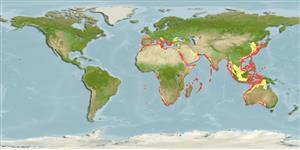Common names from other countries
Environment: milieu / climate zone / depth range / distribution range
Οικολογία
; εύρος βάθους 3 - 600 m (Ref. 804), usually 300 - 400 m (Ref. 804). Subtropical; 48°N - 37°S, 13°W - 139°E
Indo-West Pacific, Eastern Atlantic and the Mediterranean: eastern Atlantic from Gulf of Biscay to Congo and around the Mediterranean, and it is widely distributed throughout the coasts of Morocco.
Length at first maturity / Μέγεθος / Βάρος / Age
Maturity: Lm ? range ? - ? cm Max length : 7.8 cm TL αρσενικό/απροσδιόριστο; (Ref. 804)
Minimum depth from Ref. 881. Nektobenthic (demersal) or epibenthic at depths between 75 to 600 m. Infaunal feeder (Ref. 106512). Feeds on euphausiids and mollusks (Ref. 52384).
Life cycle and mating behavior
Γεννητική Ωρίμανση | Αναπαραγωγή | Γεννοβολία | Αβγά | Γονιμότητα | Προνύμφες
Members of the order Decapoda are mostly gonochoric. Mating behavior: Precopulatory courtship ritual is common (through olfactory and tactile cues); usually indirect sperm transfer.
Bianchi, G., K.E. Carpenter, J.-P. Roux, F.J. Molloy, D. Boyer and H.J. Boyer. 1999. (Ref. 804)
IUCN Red List Status (Ref. 130435)
CITES status (Ref. 108899)
Not Evaluated
Not Evaluated
Human uses
| FishSource |
Εργαλεία
Διαδικτυακές πηγές
Estimates based on models
Preferred temperature
(Ref.
115969): 8.6 - 15.9, mean 11.6 (based on 245 cells).
Ελαστικότητα
Υψηλό, ελάχιστος χρόνος για διπλασιασμό πληθυσμού < 15 μήνες (K=0.4-0.48).
Vulnerability
Low vulnerability (10 of 100).
